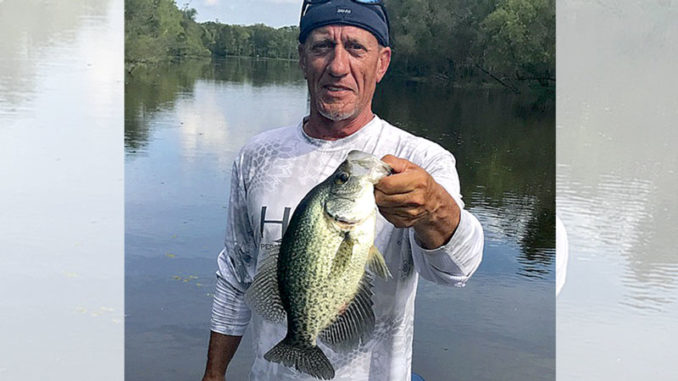
Penchant, Turtle Bayou Pipeline can be local hotspots when marsh starts to warm.
April gets a green light for awesome sac-a-lait fishing in the Bayou Black area.
Barry Henry of Morgan City, who makes the most of his time away from his job in the Gulf of Mexico, knows that perhaps better than anyone. Henry, 55, has been catching sac-a-lait for around 30 or 35 years, perhaps longer.
“Oh, yeah, this is a good time of year for the sac-a-lait,” Henry said. “It gets good. Sac-a-lait are moving up to the bank, which makes them easier to catch. That water warms up faster than water near the (Atchafalaya River). That’s why we go to Bayou Black every year. When I’m home, I go pretty much every day.”
When Henry fishes Bayou Black’s waters, he usually returns from a 4-hour trip — often with Bill McCarty of Morgan City — with 25 to 50 fish averaging between 11 and 14 inches, he said.
Henry has been pointing the bow of his boat east since he had his first boat at age 14. Why? The fishery is more stable that way than around the river at this time of year, he said.
“I’d say the marsh is a more consistent fishery. It holds more fish,” he said, adding that fish in the nation’s last great overflow swamp vamoose into the woods when the river rises above flood stage, which is 4.0 at Morgan City.
Conversely, in the marsh, he said, “They’ve got so many ponds and so many places to go they can get away from the pressure. It just holds more fish in the marsh.”
Proven spots
Henry knows how and where to catch them. His proven waters in the area include the canals off Bayou Penchant, namely the Gate, Trappers, Pecan and Willow Tree canals.
“That’s all right there in the Penchant,” he said, “and in the main Penchant bayou itself, by that time, grass starts growing back and the waters always pretty right there. Most of the time, the grass is the best producer. Find good grass, you’ll find good sac-a-lait.”
Other potential hotspots, he said, are often along the Turtle Bayou Pipeline, which runs parallel to the Penchant.
“If you catch in the Penchant, you can catch in the Turtle Bayou Pipeline. You catch in the Turtle Bayou Pipeline, the whole area produces,” he said.
When Henry heads to any of those locations, he starts fishing close to the shoreline and works his favorite soft-plastic lure back to the boat. Some fish might be close to the bank and others may be 4 to 6 feet off the shoreline, anywhere from 18 to 28 inches deep in many places.
Success can be fair to good on either an outgoing or incoming tide, he said. “But if you can catch it falling, it’s always better on a falling tide.”
Henry fishes Strike King Mr. Crappie tube jigs on a 1/32-ounce jighead.
The color?
“You can’t go wrong with the blue and white,” he said.
The 1/32-ounce weight, he said, gives the tube jig a little bit slower descent.
“Whenever you’re twitching your cork, it gives it a slower fall on the way down versus the 1/16,” said Henry, who uses 4- to 6-pound Stren mono spooled on a Zebco 33 on a 5- or 5½-foot H20 Tournament Choice fishing rod.


